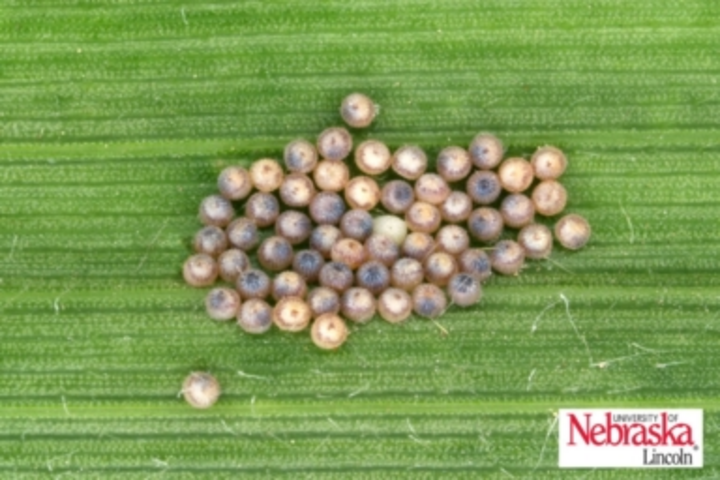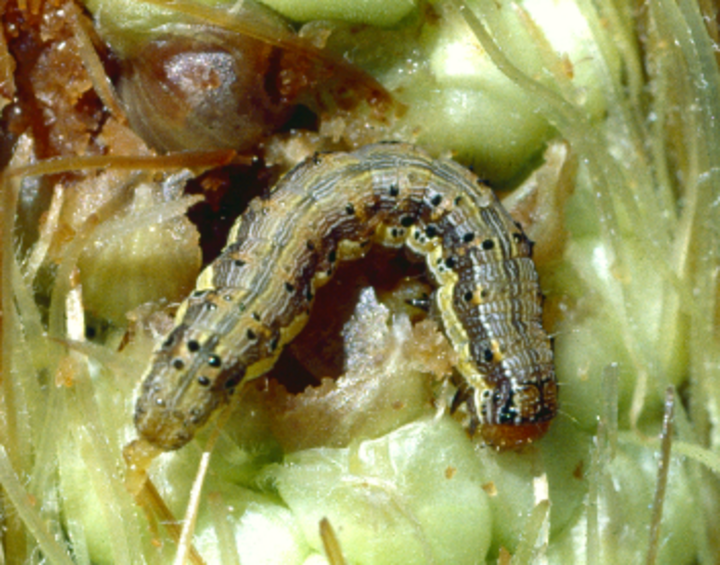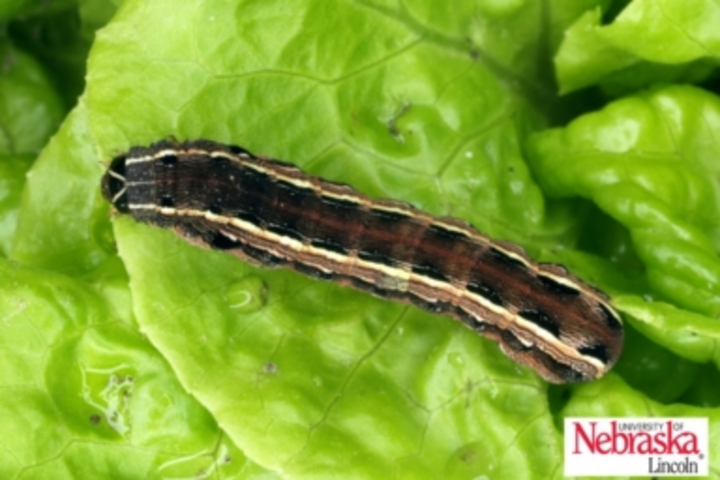Four lepidopteran pests that you may encounter feeding on corn ears in Nebraska are the European corn borer (Ostrinia nubilalis), western bean cutworm (Striacosta albicosta), corn earworm (Helicoverpa zea), and fall armyworm (Spodoptera frugiperda).
|
European Corn Borer 
|
Western Bean Cutworm 
|
Corn Earworm 
|
Fall Armyworm 
| |
|---|---|---|---|---|
| Identification |
• Flat, oval, pinhead-sized eggs turn from white to black before hatching • Whitish-grey larvae have small brown/black spots and a shiny black head • Yellowish females and darker males have wavy bands across wings 

|
• Pinhead-sized eggs turn from pearly white to purple before hatching • Young, dark brown larvae have faint diamond-like marks on their backs • Grey to pinkish older larvae have two brown rectangles behind the head • Adults have a light tan stripe, a white “eyespot,” and a white arc-shaped spot on their wings 

|
• Tiny eggs are light yellow • Larvae vary in color, but have alternating light and dark stripes and dark bumps along the length of the body • Adults are grayish-brown 


|
• Dome-shaped eggs are dirty-white to gray and have a moldy or hairy appearance • Dark green larvae have yellow/orange stripes on their sides and backs and a white, upside-down, Y-shaped marking on their head. • Grayish, mottled adults have white markings near the wing tips 

|
| Biology |
• Overwinters as larvae in corn stalks and pupates in the Spring • Females lay eggs on the underside of corn leaves, often in the middle third of the plant • Larvae present before tasseling move to the lower part of the stalk • Larvae present after tasseling tunnel into the stalk or ear • Two generations per year in Nebraska |
• Overwinters as pre-pupae in the soil • Females lay eggs on the upper side of corn leaves • Young larvae feed on pollen, tassel tissue, or green silks • Older larvae tunnel into ears to feed on developing kernels before dropping to the soil to pupate • One generation per year |
• Overwinters as pupae in the soil, but not in Nebraska • Adults return from the south each year • Females lay eggs individually on ear silks • Larvae tunnel into ears to feed on developing kernels before dropping to the soil to pupate • Multiple generations per year in warmer climates • Usually two generations per year in Nebraska |
• Overwinters as pupae in the soil, but not in Nebraska • Adults return from the south each year • Females lay eggs on immature plant leaves • Larvae feed on whorl tissue or tunnel directly into ears to feed on developing kernels before dropping to the soil to pupate • Multiple generations per year in warmer climates • Usually two generations per year in Nebraska |
| Where is it found in Nebraska? | • Statewide; anywhere corn is grown |
• Statewide, but most common in central and western regions • Common in areas where continuous corn or sandy soils prevail |
• Statewide • Also attacks sorghum, soybean, fruit and vegetable crops |
• Statewide, but most common in the east • Also attacks soybeans and some small grains |
| When is it found in Nebraska? |
• 1st gen: Late June to early July • 2nd gen: Late July, August, and sometimes early September |
• Adults fly in July • Larvae can be found July to September |
• Adults arrive in June and July from the south • Larvae are found in late July to September |
• Adults arrive in June and July from the south • Larvae are found in late July to September |
| What does damage look like? |
• 1st gen: Whorls and surrounding leaves with a “shot-hole” appearance • 2nd gen: Ear shanks, stalks, and cobs with feeding damage and entry holes |
• Damaged ears that may contain multiple larvae • Damaged ears may have a secondary fungal infection |
• 1st gen: Defoliation • 2nd gen: Damaged ears that usually contain a single larva • Damaged ears may have a secondary fungal infection |
• 1st gen: Plants with damaged whorls, defoliation, and stunting • 2nd gen: Damaged ears with potential secondary fungal infection |
|
Scouting Recommendations ***Note that peak moth flight can be determined by pheromone and light trap captures and used to inform field scouting programs |
• 1st gen: Examine 25 corn whorls at each of 4 locations in each field • Count the number of plant whorls with feeding damage and the number of live larvae per plant • Calculate the average number of live larvae per damaged plant • 2nd gen: Select 10 plants in each of 5 locations in each field and count egg masses • Consider treating if the economic threshold of 25-50% of plants with an egg mass is exceeded and corn is at blister stage or earlier |
• Select 10 plants in 5 or more areas of each field • Examine the surface of corn leaves in the upper third of the plant for egg masses and the tassel, leaf axils, and ear tips for young larvae • Treatment is recommended if 5-8% of plants are infested with eggs or larvae and if corn is at least 95% tasseled • If corn is at milk stage before eggs are laid, no treatment is needed |
• Examine silks for eggs and ear tips for small larvae during the green silking period • Treatment is not usually economically justified for field corn • Seed corn, popcorn, and sweet corn may require treatment |
• Scout late-planted fields as they reach V5-V8 • Examine ear tips for the presence of larvae • Treatment thresholds are based on defoliation levels and the potential for larvae to enter the ear |
|
Management Recommendations ***Note that pesticide applications are only effective if they reach larvae before they bore into the stalk (ECB) or enter the ears (WBC, CEW, and FAW) |
• Plant corn with one or more of the following traits: Cry1Ab, VIP3A, Cry1F, Cry1A.105, and Cry2Ab2. • Consider planting locally adapted varieties that have some resistance to ECB and yield well. • The decision to treat for either ECB generation is complicated; please consult appropriate NebGuide for guidance. |
• Plant corn with VIP3A or Cry1F traits. • Note that the efficacy of Cry1F has decreased in some areas; DuPont Pioneer no longer lists WBC as a pest controlled by Cry1F. • Scout Cry1F fields in areas where reduced efficacy has been observed, such as southwest and central Nebraska, and consider treating if thresholds are exceeded. |
• Plant corn with one or more of the following traits: VIP3A, Cry1F, Cry1A.105, and Cry2Ab2. | • Plant corn with one or more of the following traits: VIP3A, Cry1F, Cry1A.105, and Cry2Ab2. |

